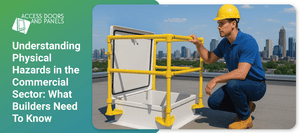Understanding Physical Hazards in the Commercial Sector: What Builders Need To Know
Posted by Access Doors and Panels on 22nd Jul 2025
On commercial building sites, every step carries risks. Project success isn't just about finishing on time or within budget; it's about worker safety. Builders, project managers, and safety workers constantly face the challenge of spotting, analyzing, and reducing physical hazards.
Poor hazard management leads to costly accidents, delays, fines, and damaged reputations.
However, a proactive approach to managing physical hazards can be a huge advantage besides being a requirement. It enhances safety, ensures compliance, improves efficiency, and cuts costs.
This article explores physical hazards and provides knowledge and steps for safer construction sites.
Why Spotting Hazards Early Is Vital in Commercial Building
If you don't know the risks, you can't prevent them. For commercial builders, this means building a safety-first culture that runs through every part of a project.
The hidden costs of ignoring safety far outweigh the money spent on preventing accidents. Beyond the immediate bills for medical care and property damage, there are long-term effects like:
- Higher insurance rates
- Possible lawsuits
- Loss of skilled workers because of unsafe conditions
- A damaged company image that can scare off future clients
Knowing and pointing out potential dangers before they get out of hand is important. So what are the four types of physical hazards that commercial builders should focus on?
Understanding the Four Main Physical Hazards in Commercial Construction
Physical hazards are everywhere in commercial construction, but we can usually group them into four main types.
1. Falls From Heights
Falls are the biggest cause of serious injuries and fatalities in construction, according to OSHA. Working high up—whether on scaffolding, ladders, or on open edges of buildings and roofs—always comes with the risk of falling.
A fall can lead to anything from minor sprains to lasting disabilities or even loss of life. To prevent these terrible events, safety measures are essential.
This includes putting up guardrails around open edges, for instance, when installing roof hatches on commercial rooftops.
The BA-RGRH Safety Rail and Gate System is a simple yet safe rail and gate system for protection when working on roof hatches. It features an OSHA-compliant design with a self-closing gate to maximize safety. It's also made from galvanized steel, making it strong and durable.
Another way to ensure safety is to use stable scaffolding and check ladders regularly for damage.
Ensure secure access at every height. Explore our OSHA-compliant ladder for commercial job sites.
2. Struck-By Hazards
Struck-by hazards involve injuries caused by falling, swinging, or moving objects. These could include equipment, vehicles, or flying debris.
The impact of struck-by incidents can range widely, from small cuts and bruises to severe trauma, concussions, or even tragic incidents.
Some preventive steps to take include:
- Making sure all staff wear high-visibility clothing
- Setting up clear barriers and no-go zones around active work areas and heavy machinery
- Putting in place proper ways for handling materials
- Securing all loads being lifted or moved
- Using trained spotters for equipment operation
3. Caught-In/Between Hazards
These hazards happen when a worker gets squeezed or trapped between or inside objects. Examples include workers caught in trench collapses, pinned between equipment and a solid object, or in unguarded machinery with moving parts.
The results are often severe, leading to serious crushing injuries and other fatalities. Because of this, prevention strategies must be strict and carried out with great care.
This means:
- Using strong lockout/tagout procedures for machinery during maintenance
- Making sure all trenches and excavations are properly sloped, shored up, or shielded
- Fitting all machinery with the right guards to keep hands and bodies away from dangerous pinch points
4. Electrical Hazards
Electrical hazards can cause electric shock, burns, electrocution, or fires. These dangers often come from exposed wires, faulty power tools, damaged extension cords, or contact with overhead or underground power lines.
Preventing electrical incidents requires strict adherence to safety rules such as:
- Ensuring all temporary power sources use Ground Fault Circuit Interrupters (GFCIs)
- Insulating all wiring and ensuring all equipment is in good condition
- Having teams follow proper lockout/tagout procedures before working on electrical systems
- Ensuring only qualified and licensed electricians do electrical work
- Seeing to it that workers stay a safe distance from all power lines, whether above ground or buried.
For robust protection of critical areas like electrical panels or HVAC systems, browse our secure and durable custom access solutions for safety in any construction project.
Advantages of Putting Safety First
For commercial builders, putting safety first brings huge benefits to your entire operation. These include:
- Better Worker Protection: Lowering the risk of injuries and life-threatening incidents protects your most valuable asset: your team.
- Guaranteed Compliance: Contractors who value safety meet local safety rules and regulations, avoiding fines, legal action, and project halts.
- Improved Project Efficiency and Timelines: Minimizing delays caused by accidents or safety problems keeps projects on track and within budget.
- Lower Operating Costs: Putting safety first reduces insurance premiums, worker's compensation claims, and hazard-related costs.
- Stronger Company Reputation: Showing a real dedication to safety builds trust with clients and attracts skilled workers, giving you a competitive edge in the market.
Make these safety advantages a reality on your site. Explore our range of safe access solutions to ensure safety post-construction, or simply request a quote.
Conclusion
Understanding and managing physical hazards in commercial construction is vital for any project's success and long-term viability. By knowing the four main types of hazards, builders can create safer, more efficient, and ultimately more profitable job sites.
It starts by putting proactive risk management plans into action and then giving your team the knowledge they need to manage physical hazards on site.
At Access Doors and Panels, we provide the right access solutions that meet construction safety protocols for secure builds. Contact us today for a consultation. Call us at +1-888-327-5471.

